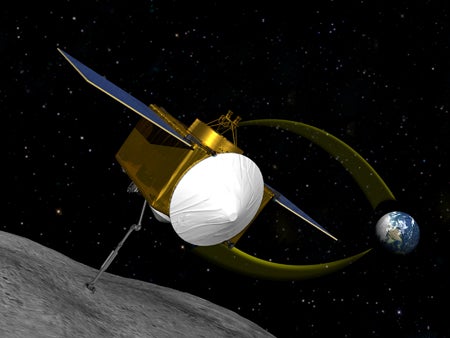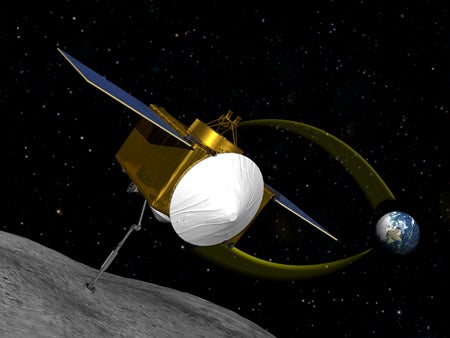 One of the world’s leading planetary science experts is chasing down a nearby asteroid to help retrieve the first-ever sample from one in orbit.
One of the world’s leading planetary science experts is chasing down a nearby asteroid to help retrieve the first-ever sample from one in orbit.
Humberto Campins, a University of Central Florida professor who discovered water ice on two different asteroids last year, has just gotten the go-ahead for the NASA-sponsored OSIRIS-REx mission.
The mission is a first-of-its-kind. The actual flight to the nearby asteroid will pose challenges because asteroids have unusual gravity fields and can rotate much quicker than planets. Navigating their space vehicle to land on this type of asteroid – millions of miles away from Earth – and scoop up a sample of “primitive” space rock also will be a first for the team.
While Campins is leaving the navigation to others on the team, he will work with lead investigator Michael Drake from the Lunar and Planetary Laboratory at the University of Arizona, on choosing the best spot on the asteroid for obtaining the sample and what this sample will tell us about the origins of life on Earth.
“This is as exciting as it gets,” Campins said from the Paris Observatory in France, where he is conducting research with European colleagues. “The asteroid fragments we will retrieve will be pristine and not modified during atmospheric entry.”
Meteorites that hit the ground can lose more than 99% of their mass, and that 99% is likely to contain the most interesting information about Earth’s water and organic molecules, Campins said.
“This sample could also hold very important clues about how the Earth and other planets in our solar system formed and evolved,” he added.
The team had eagerly been waiting to see if NASA would select their project from a list of three finalists for a slot in the space agency’s New Frontiers Missions. The mission is part of NASA’s New Frontiers Program, a science-driven program aimed at characterizing and understanding the bodies that constitute the solar system. The goal is to “illuminate the origin, evolution, and current state of the solar system.”
The non-manned mission could launch as early as 2016.
This mission is expected to cost approximately $800 million, which includes funds to design the instrument that will lasso the sample and bring it back to earth.
The money also will cover the cost to circle and analyze the asteroid for a year with an array of special instruments to help select the optimal sampling spot. That’s where a mechanism will scoop up the sample and place it in a capsule. That capsule later will come back to Earth, splashing in an ocean with the help of a parachute.
“The even harder work will begin once we have our sample,” Campins said. “We will spend at least two years going over every piece of information we gather.”
The target, asteroid RQ36, is about 600 yards in diameter and comes relatively close to Earth. The asteroid has even been designated as “potentially hazardous” because there is a 1 in 1,800 chance that it could slam into Earth in 2170.
“Sure, what we learn from this mission could help us should we need to try to avert an unlikely hit in the future,” Campins said. “But the real prize is the unique and pristine material we will find and the new insights we will gain.”
Primitive asteroids are remnants of the solar nebula, from which the Sun and the planets in our solar system formed, some 4.5 billion years ago.
NASA’s Goddard Space Flight Center in Greenbelt, Md., will provide overall mission management, systems engineering, and safety and mission assurance. Lockheed Martin Space Systems in Denver will build the spacecraft. The OSIRIS-REx payload includes instruments from the University of Arizona, Goddard, Arizona State University in Tempe and the Canadian Space Agency. NASA’s Ames Research Center at Moffett Field, Calif., the Langley Research Center in Hampton Va., and the Jet Propulsion Laboratory in Pasadena, Calif., also are involved. The science team is composed of numerous researchers from universities, private and government agencies.
